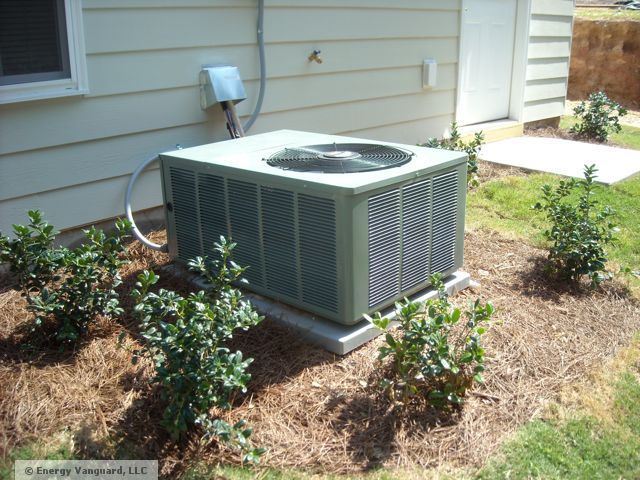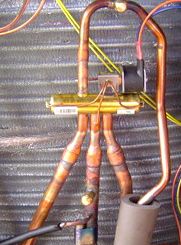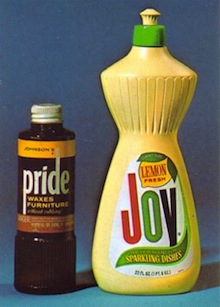3 Ways to Tell if That Contraption Is a Heat Pump or an AC

 So, you’ve got a heating and cooling system in your home. There’s a metal box outside that makes noise, and you control it with the thermostat on the wall. Can you tell me right now whether it’s a heat pump or just an air conditioner? This is a really important question to be able to answer when you’re talking to an engineer or contractor at a cocktail party.
So, you’ve got a heating and cooling system in your home. There’s a metal box outside that makes noise, and you control it with the thermostat on the wall. Can you tell me right now whether it’s a heat pump or just an air conditioner? This is a really important question to be able to answer when you’re talking to an engineer or contractor at a cocktail party.
The diference between the two is simple. An air conditioner moves heat from inside your home to outside in the summer. A heat pump does that and also moves heat from outside to inside in winter. Really, what we call an air conditioner is just as much a heat pump as the device that owns the heat pump name. It’s just that the air conditioner pumps heat in only one direction. (Refrigerators and dehumidifiers do the same thing pretty much.)
Now, back to my question, do you or don’t you know what you have? If you don’t, here’s your opportunity to do a little snooping and find out. Here are three ways:
- Go outside and find the model number of the metal noisemaker (aka the condensing unit). Type that number into the search box in your browser and see what the all-wise Internets tell you about it. You might need to type in the brand name, too. That search should get you the answer.
- Go outside and peer
 down through the grill on top of the condensing unit. If you see a horizontal brass pipe similar to the one shown in the photo at right, you’ve got a heat pump. That piece is called the reversing valve, and it’s what allows a heat pump to pump heat in both directions. Note: If you look down in there and don’t see one, that doesn’t mean it’s not a heat pump. Sometimes they’re hidden behind the access panel outside the coil, as was the case for the one in the photo.
down through the grill on top of the condensing unit. If you see a horizontal brass pipe similar to the one shown in the photo at right, you’ve got a heat pump. That piece is called the reversing valve, and it’s what allows a heat pump to pump heat in both directions. Note: If you look down in there and don’t see one, that doesn’t mean it’s not a heat pump. Sometimes they’re hidden behind the access panel outside the coil, as was the case for the one in the photo. - Go inside and set your thermostat to heat. Adjust the temperature setting until the heat comes on in your home. Now go outside and see if the condensing unit is making noise and blowing air. If it is, you have a heat pump. (Note: This doesn’t always work, but something else about the thermostat tells you the answer, too. See first comment below.)
Now that you know what you have, you’ll never be embarrassed at cocktail parties again! When that contractor starts telling you about TXVs, subcooling, and superheat, or the engineer starts talking about mean radiant temperature, comfort, naked people, and building science (you have to watch out for those engineers!), you’ll be ready.
I suggest carrying a photo of your reversing valve with you at all times. I certainly do. I keep it right next to my card with 101 digits of pi and the photo of my pride and joy.

Related Articles
How NOT to Use Your Heat Pump Thermostat
How the Heck Does a Heat Pump Get Heat from Cold?!
This Post Has 10 Comments
Comments are closed.

The quickest way for most
The quickest way for most people to tell is if the thermostat has an “emergency heat” setting. Most “all electric” homes (no gas or propane service) are heat pumps, although some just use heat strips for heat.
The #3 suggestion of yours will work for most systems, but some systems will turn off the compressor and run strip heat or a gas furnace when stage 2 heat is engaged.
In our area 6 out of 10 homes are regular gas furnace/AC. 2 out of 10 are heat pumps, straight strip heat is 1 out 10 homes. Gas furnace with heat pump (aka “dual fuel”) is 1 out of 10 homes.
Apartments are almost always strip heat, although sometimes we will see a gas furnace in one. I haven’t seen a dual fuel or heat pump in an apartment yet.
Bob: Good
Bob: Good points. I’ve added a note to the article about the exception you mentioned. I think the numbers here in Atlanta are similar to yours, mostly furnace/AC. The state energy code banned using strip heat as a primary heat source, so fortunately we’re not getting new installations of that expensive heat source.
Allison:
Allison:
I thought you’d learned your lesson about using product labels in your blog; I expect P&G; lawyers will be sending cease & desist letter soon. 😉
I’m often trying to make this
I’m often trying to make this determination in conversations with utility customers over the phone. I used to ask first about lights on the thermostat (emergency heat) but this doesn’t work on many newer digital tstats. One of our energy auditors says he looks for heat pumps’ 3 Schrader valve connector ports (not 2) for gauge connection. Even if the system is determined to be a heat pump, it isn’t certain to be operating as a heat pump. I know from experience not to rely on the little ARI sticker on the condensor unit that says in tiny print “Listed Section of Unitary Heat Pump” — a split system may have that sticker outside, and likely has a reversing valve, but may not operate as a heat pump (owing to thermostat wiring errors, or less often, condensor unit wiring for cool-only). Older air handlers were ARI-stickered “heat pump” or “strip furnace”, but not any more. When in doubt, observing the outdoor fan spinning in heat mode is comforting. But it won’t spin if its breaker is tripped — and occasionally heat pump owners go all winter like that, heating with strips only.
You can also look on the
You can also look on the nameplate “metal noisemaker (aka the condensing unit)”, where you find the model number and serial number.
Quite often the manufacturer will label the product as a Heat Pump component. Then you still need to see the reversing valve to see if it really is installed as a heat pump. Those crazy techs do some interesting things!
However, you still do not know if it is installed properly to FUNCTION as a heat pump.
I have seen many heat pumps, in almost all states and climates, that were actually wired so that when heat was called, ONLY the electric strips or gas furnace energized. The other trick used is to install an outdoor thermostat (recommended for all HP installs and intended to lock out supplemental heat ABOVE the thermal balance point, but then set the T-stat to about 50F. Effectively adding strip heat (significantly reducing efficiency but ensuring “warm” air), or locking out the DX completely on gas “piggy back” systems, anytime heat is called. This is actually the way they installed my heat pumps! (Atlanta 1996)
The problem is that HVAC contractors often think “heat pumps will not work [here].” Insert almost any location for the word here. So if the salesman can’t talk you out of it, they simply circumvent the control strategy to work/not work as they think is best.
As the blog shows there are
As the blog shows there are considerable “rules of thumb” for determining the equipment type. Each has it’s own advantage and disadvantage. The disadvantages are the problem because the thumb is very narrow and does not fit many situations.
Here’s my take and solution starting with the simplest. Each yes answer typically means you have a heat pump condensing unit.
1. check the t’stat, does it have a red or blue light? If electronic you’re on your own, most will indicate aux. heat with a light, bell, whistle, or small trained animal standing nearby.
2. Look in the top of the condensing unit (with the unit disabled so it cannot run and the fan blows in oyur eyes). Heat pumps will have a reversing valve as shown above with a lot of piping, 4 lines always, very easy to spot. Second, heat pumps will have two “big black tanks”. One is the compressor motor (vapor pump), the other is a suction line accumilator to protect the compressor when the reversing valve switchs over the unit.
3. A “straight cooling” condensing unit has virtually nothing inside the unit except the compressor and pipes connecting it to the coil.
To clarify a point.
Heat pumps are very efficient when the ambient temperature is above 40 degrees F. Below 40 F and they are losing the game. Because of this limitation, all heat pumps will have electric heat strips or some other heating mode for the cold nights. This is why you have the red or blue light on the t’stats.
Look at the heating degree days for the local area to best determine the effectiveness of a heat pump. If you have many nights, more than a dozen or so, where the average nightly temperature will remain below 40 F you are spending money. Gas or oil rules below 40 as far as efficiency and cost goes. Use duel fuel for optimum savings. In other words use a heat pump condenser coupled with a gas or oil furnace. When the temperature falls below 40 ish, the gas/oil heat kicks in and takes over giving more heat and much less expensive heat.
For those with a typical heat pump and air handler with electric heat strips…. Have a technician wire in a lock out control for the condensing unit. This simple wiring and relay will lock out the condenser from trying to provide heat when the temperature is too low to be effective. This will also limit the “defrost cycle” saving a lot of energy. Heat strips will not run excessively with this wiring change because they are already providing 90 + % of the heating at these lower ambients. The heat pump condenser (i.e. compressor and fan) are simple waisting money and run time, shortening their life span. All manufacturers have a lock-out kit available with a relay and wiring instructions, very simple.
These reasons above are why you can expect to see heat pumps in the 35 degree and lower latitudes, above there you start waisting money or going to gas or oil. Get into the northern climes and you will see boilers because of their efficiency. In the south, a/c technicians are called just that. In the north they are called “wet technicians” because most are great boiler techs.
Keith,
Keith,
I disagree about your recommendation to lock out the heat pump below 40F, or that HPs do not work above “35 degree latitudes.” See my enter location statement above.
In fact, even in Chicago, IL, about 85% of all heating hours are above freezing. The switch-over point would properly be defined by the thermal balance point, and/or the economic balance point. In new, EE construction, this point is often at, or below, freezing. Yes, there are precautionary reasons you might want to limit operation below mid-30s to reduce ice build up though.
Bottom line is that the most economical system is sometimes straight electric baseboard heat when the home is super efficient. A high-tech system is simply unnecessary. In days past (may be different now) electric utilities offered incredibly low “winter” rates, which further justified considering electric baseboard, or even a ducted air handler, IF ducts are located inside the building envelop.
Your points about stepping through checks to see if you have a heat pump, and how it is operating are valid though.
Geoff, your rebuttal of Keith
Geoff, your rebuttal of Keith’s nonsense on heat pump lock outs and latitude guidance is spot on. I routinely specify heat pumps in northern climates, for the reasons you said. I recently did a BIN analysis for a client in Bangor Maine — 72% of heating hours are above 30F, and 51% of the heating degree hours are above 30F. Even with gas prices at decadal lows, a high efficiency gas furnace can’t compete with a heat pump when temps are above freezing, except perhaps in markets with unusually high winter electric rates.
Below the thermal balance point, a heat pump’s efficiency and capacity don’t fall off a cliff. Even at 0F, a mid-efficiency heat pump has a COP of about 2.0 and produces around 40% of rated capacity. But if supplemental heat is fueled by natural gas, compressor lockout may be warranted at the economic balance point, which may be relatively close to the thermal balance point. It all depends on local energy prices.
I have one minor nit regarding your previous comment on dealers who lock out DX on piggy-back systems. Aside from economic considerations, lockout is required with furnace heat pump dual fuel systems because of the design (DX coil on supply side). That’s why I prefer using a hydronic fan coil for supplemental heat (in cold climates), and use a condensing tankless water heater to service DHW and supplemental heat.
A lot depends on electric
A lot depends on electric rates in your area. In Oklahoma City, gas is only $6.00 per decatherm, but there is a $27/mo meter charge. For us a heat pump doesn’t make sense even at a low winter rate @4.7 cents per KWH. The first 600KWH in winter are 8.4 cents, but if you have electric heat you will most likely go over 600KWH in a month.
I ran the numbers when considering a duel fuel system and the numbers simply don’t make sense. Either go straight gas heat or to a all electric home.
Thanks for all the great&
Thanks for all the great—and detailed—comments. You guys have put a couple of other blog posts worth of information in there.
Dave, I haven’t heard anything from P&G;’s lawyers yet. Maybe it’s because I didn’t show their Pride & Joy installed incorrectly. ;~)